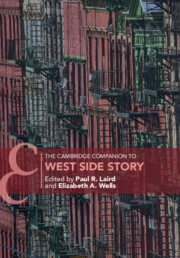Book contents
- The Cambridge Companion to West Side Story
- Cambridge Companions to Music
- The Cambridge Companion to West Side Story
- Copyright page
- Contents
- Figures
- Music Examples
- Contributors
- Preface
- Acknowledgements
- Part I Before West Side Story
- Part II The Work Itself and Its Context
- 7 The Score
- 8 Un-Gendering ‘Somewhere’
- 9 Shakespeare in the City
- 10 West Side Story and the Hispanic Problem
- 11 West Side Story and the Intersections of Class, Colourism, and Racism
- 12 The Real Gang History of New York
- Part III The Legacy
- Select Bibliography
- Index of Songs
- General Index
11 - West Side Story and the Intersections of Class, Colourism, and Racism
from Part II - The Work Itself and Its Context
Published online by Cambridge University Press: 09 January 2025
- The Cambridge Companion to West Side Story
- Cambridge Companions to Music
- The Cambridge Companion to West Side Story
- Copyright page
- Contents
- Figures
- Music Examples
- Contributors
- Preface
- Acknowledgements
- Part I Before West Side Story
- Part II The Work Itself and Its Context
- 7 The Score
- 8 Un-Gendering ‘Somewhere’
- 9 Shakespeare in the City
- 10 West Side Story and the Hispanic Problem
- 11 West Side Story and the Intersections of Class, Colourism, and Racism
- 12 The Real Gang History of New York
- Part III The Legacy
- Select Bibliography
- Index of Songs
- General Index
Summary
The creators of West Side Story were liberal artists who updated Romeo and Juliet amidst youth gangs and racism, and each felt the sting of discrimination because they were Jewish and gay, but neither good intentions nor their own status as ‘Others’ in American society allowed them to realize fully the class advantages they had over the Puerto Rican minorities depicted in their show. Through consideration of Theodor Adorno’s concept of ‘Culture Industry,’ what one learns about Bernstein from his 1970 meeting with the Black Panthers immortalized as ‘Radical Chic’ by Tom Wolfe, Teju Cole’s concept of the ‘White Savior Industrial Complex,’ how the show has been cast, and other lenses, the author demonstrates how West Side Story can be described as insensitive in areas of class, the politics of colour, and race. The chapter also considers Bernstein’s cultural appropriation of African American and Latinx tropes in his music.
Keywords
- Type
- Chapter
- Information
- The Cambridge Companion to West Side Story , pp. 188 - 197Publisher: Cambridge University PressPrint publication year: 2025

